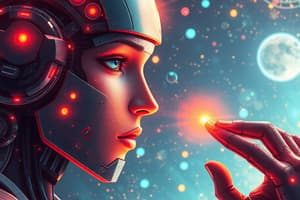Podcast
Questions and Answers
What was the primary purpose of the Perceptron created by Frank Rosenblatt?
What was the primary purpose of the Perceptron created by Frank Rosenblatt?
- To recognize and identify images without human assistance (correct)
- To showcase the capabilities of electronic computing
- To perform complex mathematical calculations
- To encrypt and decrypt information
How many trials did the Perceptron take to learn to distinguish basic cards with markings?
How many trials did the Perceptron take to learn to distinguish basic cards with markings?
- 50 trials (correct)
- 100 trials
- No trials needed
- 10 trials
What was a major limitation of the Perceptron according to the content?
What was a major limitation of the Perceptron according to the content?
- It was designed for specific environments only
- It failed to carry out complex tasks (correct)
- It could not process numerical data
- It required constant human supervision
What assertion did Rosenblatt make about the Perceptron and biological brains?
What assertion did Rosenblatt make about the Perceptron and biological brains?
What was the general perception of the Perceptron in the field when it was first developed?
What was the general perception of the Perceptron in the field when it was first developed?
What key development in computer science does Rosenblatt's work relate to today?
What key development in computer science does Rosenblatt's work relate to today?
In what year did the New York Times publish its article about the Perceptron?
In what year did the New York Times publish its article about the Perceptron?
What challenge did the Perceptron face in learning tasks?
What challenge did the Perceptron face in learning tasks?
What is a significant reason that computers struggle with perception compared to humans?
What is a significant reason that computers struggle with perception compared to humans?
Which of the following best captures a mistake made by computers in perception?
Which of the following best captures a mistake made by computers in perception?
Why did early computer scientists underestimate the time required to achieve human-like perception in computers?
Why did early computer scientists underestimate the time required to achieve human-like perception in computers?
What aspect of perception is described as seemingly effortless for humans?
What aspect of perception is described as seemingly effortless for humans?
Which statement about computer vision from 60 years ago is true?
Which statement about computer vision from 60 years ago is true?
In what way does a computer misinterpret a familiar object if it has never seen it before?
In what way does a computer misinterpret a familiar object if it has never seen it before?
What development has been observed in computer vision over the past six decades?
What development has been observed in computer vision over the past six decades?
What is one common misconception about how computers perceive images?
What is one common misconception about how computers perceive images?
Study Notes
Early Attempts at Artificial Perception
- In 1958, the New York Times reported on the creation of the Perceptron, a computer designed to learn and perceive its environment.
- The Perceptron, created by Frank Rosenblatt, was a large computer capable of learning to distinguish basic images, such as cards with markings.
- Rosenblatt believed the Perceptron could mimic the perceptual processes of a human brain.
- The Perceptron was not successful. It took many trials to learn simple tasks, and more complex tasks proved challenging.
- The limitations of the Perceptron highlighted the complexity of human perception.
- Despite its shortcomings, the Perceptron laid the foundation for advancements in artificial intelligence.
Modern Artificial Intelligence and Perception
- Despite significant progress, computers still struggle to perceive as effectively as humans.
- Modern computers often misinterpret images due to a lack of the vast knowledge base humans possess.
- Early computer scientists underestimated the complexity of perception, leading to unrealistic expectations for AI development.
- The ease with which humans perceive their environment often masks the intricate processes involved.
Studying That Suits You
Use AI to generate personalized quizzes and flashcards to suit your learning preferences.
Description
Explore the early attempts at artificial perception from the creation of the Perceptron in 1958 to modern challenges in AI image interpretation. This quiz delves into the complexities of computer vision and the limitations faced in mimicking human perception. Discover how these initial efforts shaped the foundations of artificial intelligence.




